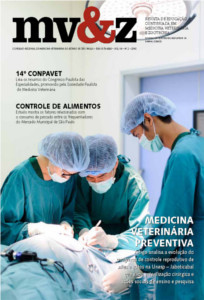Ocorrência e características clínicas e laboratoriais de cães infectados por micoplasmas hemotrópicos (Mycoplasma haemocanis e Candidatus Mycoplasma haematoparvum): estudo de quatro anos em animais atendidos em hospital veterinário localizado no município de São Paulo, Brasil
##plugins.themes.bootstrap3.article.main##
Resumo
As infecções caninas por hemoplasmas são geralmente crônicas
e assintomáticas e, sob situações de imunossupressão,
coinfecções com outros agentes etiológicos ou esplenectomia,
podem gerar anemia e emaciação, dentre outras manifestações
clínicas. O presente trabalho analisou os prontuários de
194 animais da espécie canina atendidos no Hospital Veterinário
Pet Care, na cidade de São Paulo, Brasil, no período
de 2011 a 2015 e submetidos à PCR em tempo real para
Mycoplasma haemocanis e Candidatus Mycoplasma haematoparvum,
e descrevendo as principais características clínicas
e laboratoriais dos pacientes infectados. Dos 194 animais observados,
cinco machos (71,42%) e duas fêmeas (28,57%)
apresentaram-se infectados pelos hemoplasmas acima referidos,
determinando uma frequência de ocorrência de 3,6%.
Dos sete pacientes positivos, seis eram idosos, com idade entre
oito e 18 anos (87,71%) e todos apresentavam comorbidades,
com destaque para erliquiose (57,14%). Anemia foi
encontrada em dois cães (28,57%) e trombocitopenia em
três (42,85%), e todos os animais com contagem plaquetária
diminuída apresentaram-se coinfectados por E. canis. Não se
observou correlação entre a infecção pelos micoplasmas, febre
e contagem leucocitária nos animais positivos. A conclusão
obtida é de que, na população investigada, a frequência
de ocorrência de infecção por Micoplasmas hemotrópicos foi
baixa e os casos observados predominaram em machos e idosos
coinfectados por Ehrlichia canis.
##plugins.themes.bootstrap3.article.details##
1. Autores mantém os direitos autorais e concedem à revista o direito de primeira publicação, com o trabalho licenciado sob a Creative Commons Atribuição-NãoComercial-SemDerivações 4.0 Internacional
2. Autores têm autorização para assumir contratos adicionais separadamente, para distribuição não-exclusica da versão do trabalho publicada nesta revista (ex.: publicar em repositório institucional ou como capítulo de livro), com reconhecimento de autoria e publicação inicial nesta revista.
3. Autores têm permissão e são estimulados a publicar e distribuir seu trabalho online (ex.: em repositórios instituicionais ou na sua página pessoal) a qualquer ponto antes ou durante o processo editorial, já que isso pode gerar alterações produtivas, bem como aumentar o impacto e a citação do trabalho publicado (Veja O Efeito do Acesso Livre);
